Remains of mysterious Somerton Man exhumed for DNA testing almost 73 years after he was buried
The unknown Somerton Man has been exhumed and placed into a new coffin to be transported for forensic testing. Police say his remains are in “reasonable” condition for DNA extraction.
SA News
Don't miss out on the headlines from SA News. Followed categories will be added to My News.
The Somerton Man has been exhumed and placed into a new coffin, in a new bid to extract his DNA to finally solve the 73-year-old mystery of his identity.
It took police and anthropologists 12 hours exhume the body from the West Terrace Cemetery gravesite, where the unidentified man has been buried since 1949.
Adelaide Cemetery Authority pallbearers brought a new empty coffin marked ‘Unknown Somerton Man’, with the date of his death on December 1, 1948, to his gravesite after the exhumation was complete, and respectfully carried the dead man’s remains to a police van.
The process was symbolic of transferring the care from the authority to police.
Listen to the audio version of this article
It is a legal requirement for the body to leave the cemetery site in a coffin.
Detectives and anthropologists were at the cemetery from 5am Wednesday to exhume the remains of the unknown man, who remained unidentified after he died on Somerton Beach.
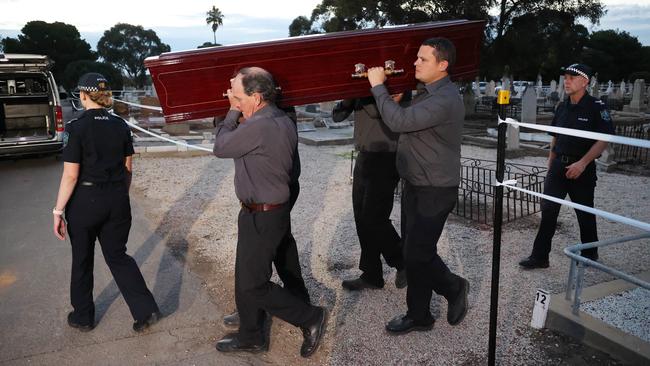
Head of SA Police’s Major Crime Branch, Detective Superintendent Des Bray, said the exhumation was a success.
“He’s now been formally delivered into our care to take to the Forensic Science Centre,” he said.
Det Supt Bray said police would work closely with the forensics team to determine what their next steps would be in coming days.
“We’re extremely happy with how the day went. We’re happy that we’ve removed the complete remains of the Somerton Man.”
He said he was confident in the skills of the forensics team to take the identification process forward.
“The remains we’ve got today are in reasonable condition and we think that will give us a reasonable opportunity to obtain a DNA sample. What work we do will be dependent on the amount of DNA and the quality of the sample.”
With the body, police found an old grave nameplate.
If no family comes forward – should the DNA identification process be successful – the Somerton Man will be returned to his established grave at the West Terrace Cemetery.
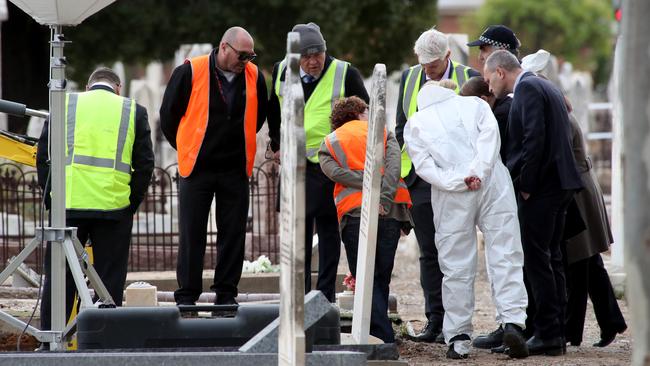
The exhumation was the latest bid to solve one of Australia’s most enduring mysteries.
The much-anticipated development in the almost 73-year-old case comes just weeks after The Advertiser revealed Attorney-General Vickie Chapman had given approval for the move.
Major Crime detectives are hoping advances in forensic technology may enable a DNA profile to be extracted from the remains to identify the mystery man and possibly shed light on how he died.
Professor Anne Coxon, from Forensics SA, said it would likely not be known for weeks whether DNA can be extracted from the Somerton Man’s remains – let alone whether a genetic match can be found.
Forensic scientists will have to attempt to extract DNA before they know whether any is available to take, said Prof Coxon, who is at this morning’s dig.
Depending on how much DNA is taken, scientists will try to match it to genetic databases to find a relative.
There is no guarantee a match would be found.
SEE AERIAL FOOTAGE OF THIS MORNING’S DIG

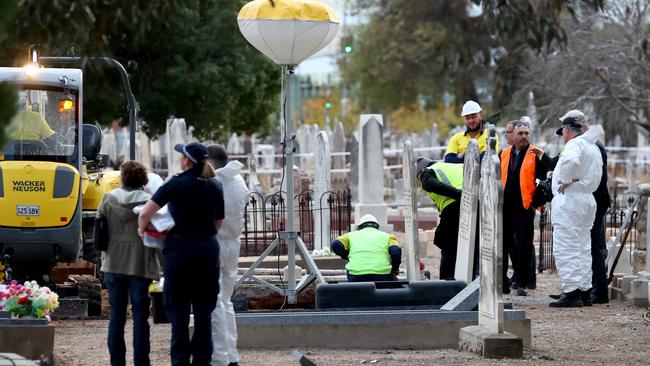
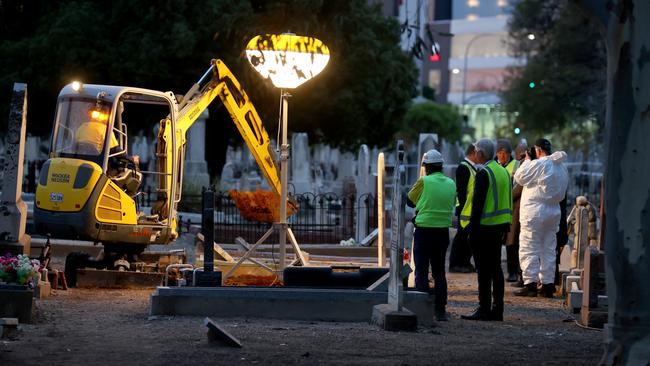
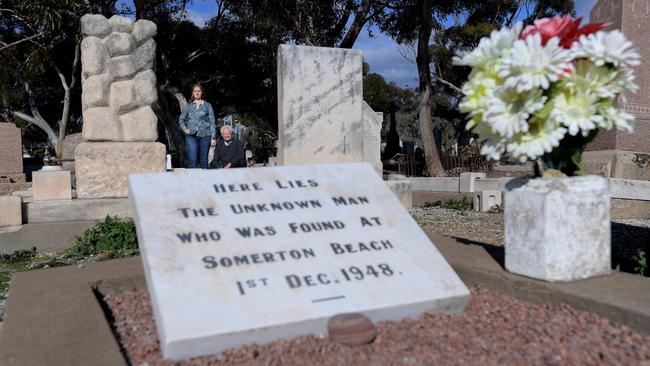
On Wednesday morning, Detective Superintendent Des Bray said the exhumation was being done with dignity and respect.
“The Somerton Man is not just a curiosity or a mystery to be solved. He’s somebody’s father, son, perhaps grandfather, uncle, brother, and that’s why we’re doing this and trying to identify him,” he said.
Earlier, he said the exhumation was another step in the active investigation into the case.
“Following recovery of the remains, Forensic Science SA will attempt to recover a DNA profile from the man,” he said.
“If a DNA profile can be obtained … a forensic case meeting will be held to formulate the most appropriate DNA strategy, which will then require considerable investigation work to have any chance of identifying the man or where he originated from.”
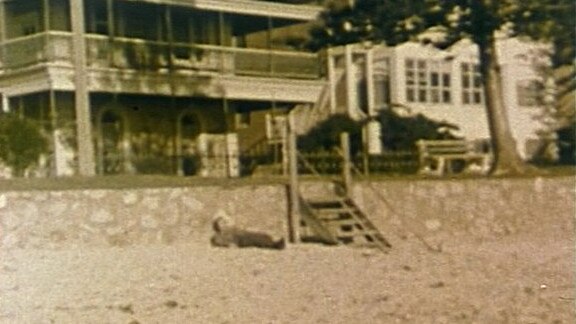
OUR REPORTER ON THE SCENE BEFORE THE EXHUMATION
The mystery of the Somerton Man, who was discovered slumped against concrete steps at Somerton Beach early on December 1, 1948, has captivated the public for decades.
The many theories behind the mystery include that he was a Russian spy who was poisoned because of a suspected code written inside a discarded poem book that was linked to the Somerton Man through a small section of page ripped from the book and found in the fob pocket of his pants.
Others are that he was simply an American sailor who travelled to Adelaide to visit a child he had fathered during the war years and died of natural causes or he was a merchant seaman who had overstayed his visit to Australia.

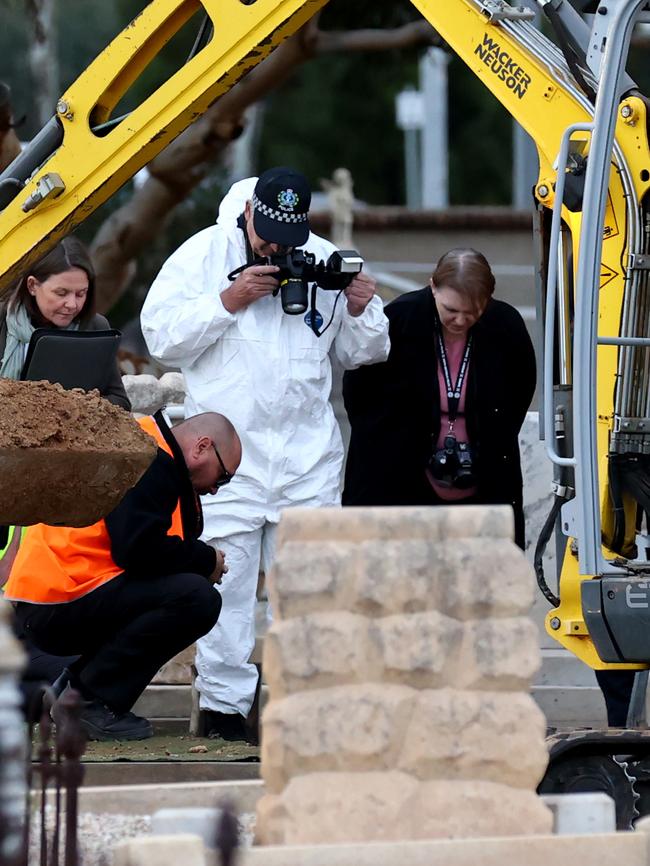
A post-mortem failed to provide any conclusive cause of death, but poisoning could not be ruled out.
Forensic science SA’s assistant director of operations Anne Coxon said the technology now available was “light years ahead’’ of the techniques available when the remains were discovered.
“Tests of this nature are often highly complex and will take time, however we will be using every method at our disposal to try and bring closure to this enduring mystery,” Ms Coxon said.
Ms Chapman said she believed the FSSA team was well equipped to handle the challenging task.
“For more than 70 years people have speculated who this man was and how he died,” she said.
“It’s an enduring mystery – but I believe that, finally, we may uncover some answers, thanks to the combined expertise of SA Police and FSSA.”
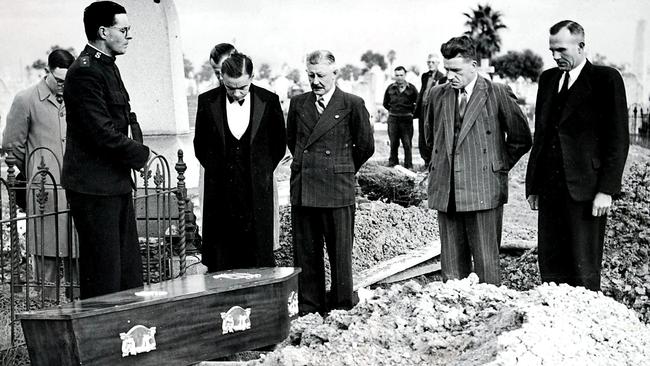
While there were no visible wounds found on the Somerton Man’s body during his post mortem, there has been speculation he may have died of poisoning because no other cause of death was discovered.
It is possible advances in forensic technology may also be able to identify traces of toxins from bone samples that will be examined following the exhumation.
Detectives have waited until now to apply for his exhumation because of the significant advances in forensic DNA technology in recent years that will greatly improve the chances of successfully obtaining a profile.
While the aim of the exhumation is to obtain a DNA profile from the Somerton Man’s skeletal remains, that may prove to be a difficult task. He was embalmed following his post mortem and the formaldehyde used in that process is known to degrade DNA.
If a DNA profile can be obtained it could be used to search for a familial match using Australian and international policing and genealogy databases, including those used by Interpol.
Any profile obtained will also be compared to individuals living in SA who claim they may be related to the Somerton Man using familial DNA testing technology.
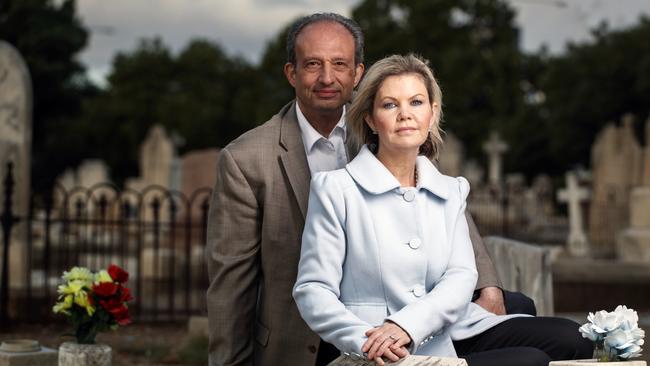
The exhumation is being conducted as part of Operation Persevere, which covers long-term missing persons and unidentified human remains in South Australia.
It runs in tandem with Operation Persist, under which cold case homicides are actively investigated.
Over the past decade, there have been numerous calls to exhume the Somerton Man’s remains, with former Attorney-General John Rau twice refusing a request by Adelaide University Professor Derek Abbott, who has been researching the case for more than a decade and claims it is possible his wife Rachel is the Somerton Man’s granddaughter.
On Wednesday morning, Prof Abbott visited the cemetery and called it a “tremendous day”.
“It is a credit to the SA police force that they have managed to get the approval for this exhumation and I think it means a lot also to the state because many people in SA want to see a resolution to this mystery,” Prof Abbott said.
“There’s a feeling of being pleased it’s going ahead and we’ll get a resolution, hopefully, but a sombre feeling because we are disturbing the remains of a grave.”
More Coverage
Originally published as Remains of mysterious Somerton Man exhumed for DNA testing almost 73 years after he was buried



